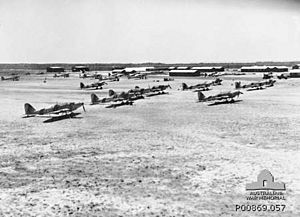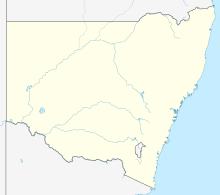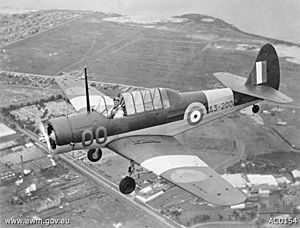Evans Head Memorial Aerodrome facts for kids
Quick facts for kids
Evans Head Memorial Aerodrome
|
|||||||||||
|---|---|---|---|---|---|---|---|---|---|---|---|

Fairey Battle aircraft of 1BAGS at RAAF Evans Head in 1941
|
|||||||||||
| Summary | |||||||||||
| Airport type | Public | ||||||||||
| Operator | Richmond Valley Council | ||||||||||
| Location | Evans Head, New South Wales | ||||||||||
| Elevation AMSL | 20 ft / 6 m | ||||||||||
| Coordinates | 29°05′36″S 153°25′12″E / 29.09333°S 153.42000°E | ||||||||||
| Map | |||||||||||
| Runway | |||||||||||
|
|||||||||||
|
Sources: AIP
|
|||||||||||
The Evans Head Memorial Aerodrome (airport codes: EVH, YEVD) is a special airport in Evans Head, Australia. It's about 1 kilometer north of the village. This airport is important because of its history.
During World War II, it was a major base for the Royal Australian Air Force (RAAF). It was called RAAF Station Evans Head. It helped train many aircrew for the war. Today, only one runway is still used by private planes. The aerodrome is listed on the New South Wales State Heritage Register as a place of historical importance.
The local council and a group called the Evans Head Memorial Aerodrome Heritage Aviation Association (EHMAHAA) are working to restore parts of the old base. They have fixed up a large old aircraft hangar called a Bellman hangar. This hangar now displays an RAAF F-111 plane and other items from the airport's past. You can visit the museum on weekends.
Contents
History of Evans Head Aerodrome
Building the Airfield for War
An airfield was first built at Evans Head in 1936. It was meant to be a place where planes could land in emergencies. In 1937, the Australian Government took over the airfield. They wanted to use it as a military base. More land was bought, and work was done to prevent floods between 1939 and 1940.
In December 1939, a big training program started. It was called the Empire Air Training Scheme. Australia agreed to train 28,000 aircrew over three years. The No 1 Bombing and Gunnery School (1BAGS) was set up at RAAF Station Evans Head. It was fully ready by December 1941.
Sir Valston Hancock was the first leader of the base. He helped choose the location and design the station. Large areas for bombing and gunnery practice were set up. These areas covered a huge space of about 1,500 square kilometers.
Training Aircrew for Battle
The school trained people for many roles. These included bomb aimers, wireless operators, air gunners, and navigators. The main planes used for training were the Avro Anson and the Fairey Battle light bomber. About 70 of these planes flew from Evans Head.
When Japan joined the war in late 1941, RAAF Evans Head became very important. It was close to Brisbane, making it a key place to defend against attacks. To protect the base, 19 gun pits were built. They had machine guns to defend the airfield. Planes from the base also flew along the coast to watch for danger.
Many large, movable hangars called Bellman hangars were put up at the base. There was also a special unit for sea search and rescue. It operated from its own docks in the nearby town. The base had homes for up to 1400 people. It also had a hospital, and places for fun activities.
More than 5,000 trainees learned skills at No 1 Bombing and Gunnery School. This included the famous actor Chips Rafferty. Sadly, over 1,000 of these trainees died during the war.
In 1943, the bombing and gunnery school closed. Another school, No 1 Air Observers School, moved to Evans Head. They used Avro Anson and CAC Wackett planes. About 630 aircrew finished their training here before this school also closed in 1944.
Other Airfields Nearby
- Coraki Airfield was used as a backup base.
After the War: A Changing Role
After World War II, the airfield was used for a short time by commercial airlines. Butler Air Transport was the main airline. The Department of Defence still owned the airport. In 1952, the airport was given to the Department of Transport.
Queen Elizabeth II visited the airfield in 1954 during her tour of Australia. Most of the old RAAF buildings were taken down or moved in the 1950s. By the mid-1950s, commercial flights moved to the larger town of Casino.
Since then, the airfield has been used for emergency landings. It was also a place to store old RAAF planes and military supplies. It has helped with flood relief operations too.
In 1985, Evans Head was briefly reopened for commercial flights. This happened during upgrades at Casino Airport. The main runway was made longer to 1300 meters. This allowed larger planes like the Fokker F.27 to use the airport.
In 1992, the airport was given to the local council. It is now owned by Richmond Valley Council. On November 22, 2002, the Evans Head Memorial Airport was added to the NSW State Heritage Register. This means it is officially recognized as an important historical site.
Plans for an Airpark
In 2009, a group called Evans Head Airpark Pty Ltd. suggested a plan. They wanted to buy and develop the airfield. Their idea included building homes for people who own planes. It also planned for aviation businesses, passenger services, a museum, and a hotel. This group included well-known people like Peter Lynch, Red Bull Air Race pilot Matt Hall, and Ironman Grant Kenny.
In 2011, the group announced they were trying to get old RAAF planes. They wanted to display decommissioned DHC-4 Caribou and F-111 aircraft. These would be shown in the museum, which would be based in the old Bellman hangar.
Important Events and Accidents
- On November 10, 1944, seven Bristol Beaufighter planes from RAAF Base Williamtown practiced an attack on Evans Head airfield. Two planes crashed into shallow water, about 14 kilometers south of the airfield. All four crew members on board died.
- On September 29, 1977, an F-111C plane was hit by birds. This happened during a training flight at the Evans Head Air Weapons Range. The birds hit the cockpit, making the crew unable to fly. The plane crashed, and the crew died.
- On April 11, 2008, another F-111 hit a pelican at the Evans Head range. This caused a lot of damage to the front of the plane and one engine stopped working. The crew decided to fly back to RAAF Base Amberley instead of landing at Evans Head.
Why Evans Head Aerodrome is Special
The Evans Head Memorial Aerodrome is important for its history, community value, and culture. It is believed to have been the largest RAAF training base in the Southern Hemisphere during World War II. Over 5,000 people trained there. It played a big part in training aircrew for the war effort.
The site still has one original Bellman Hangar. This type of hangar showed new building ideas for its time. Sir Valston Hancock, who designed these hangars, later became the first leader of the base.
The aerodrome is also important to the many service members who were based there. It is remembered during ANZAC Day celebrations. It is also special to the people of the North Coast region and visitors. Its large size makes it a clear landmark from the ground and the air. It continues to be a cultural site for the area.
The Evans Head Memorial Aerodrome was added to the New South Wales State Heritage Register on November 22, 2002. This is because it meets several important requirements:
A Key Part of New South Wales History
This place is historically important because it was the No 1 Bombing and Gunnery School (BAGS). This school was part of the huge Empire Air Training Scheme (EATS). This scheme trained many aircrew to help the Allies in World War II.
Over 5,000 RAAF personnel trained here during WWII. They went on to serve in Australia and overseas. More than 1,000 of them lost their lives during training or in active service.
Connected to Important People and Groups
The aerodrome is historically important because of its link to Sir Valston Hancock. It also had 17 Bellman Hangars, though only one remains in its original spot. These hangars were designed and built under Sir Valston Hancock's guidance. He was the RAAF's Director of Works and later the base's commanding officer.
The site also has connections with US Air Force personnel. They trained and served alongside Australian RAAF members. Some US B-25 bombers even landed or crashed near Evans Head.
Showing Great Design and Skill
The aerodrome is special because of its striking appearance. Its large size gives it a strong sense of place. Its location near Evans Head village and the coast highlights its important position during the war. It is one of the few remaining large coastal sites that still feels like a wartime operation base.
The aerodrome was built with four runways that crossed each other. This design allowed planes to land no matter the wind or weather. This type of design was usually only used for very large airports.
The Bellman Hangar design was an Australian solution to a steel shortage during WWII. Steel was needed for weapons, so the Bellman Hangar was made using early prefabrication methods. This allowed hangars to be built quickly for wartime use.
Important to the Community
The aerodrome is very important to the Australian RAAF personnel who served at Evans Head. It is also a legacy for their families. People from other countries, like the UK, Holland, the US, and Canada, also trained or were based here.
This aerodrome is a significant landmark from WWII. It has strong ties to the people of Evans Head and the North Coast region. The remaining buildings and sites in Evans Head are important reminders of the RAAF Base during the war.
The RAAF's presence during and after the war helped the town grow. Many personnel stayed in the village after the bombing and gunnery school closed. The connection between the aerodrome and the town is a key part of the village's identity.
A Place for Learning and Discovery
The aerodrome is important for technical and research reasons. The technical innovations and the role of the RAAF Base were very important to Australia's efforts in WWII.
The prefabricated Bellman Hangar and other buildings show important technical advances for that time. While other Bellman hangars exist in Australia, the one at Evans Head was one of the first built here. Other structures like the Scout Hall and Tuck Shop are good examples of the original designs.
The history of the RAAF Base, the aerodrome, and its structures is a great topic for high school students to study. There are discussions about creating a program for this.
A Rare and Unique Site
This aerodrome is rare because of its unique role as the main bombing and gunnery school under the EATS. This has been shown in a study of WWII aerodromes in NSW.
Protecting and managing this site is very important. It is one of the largest WWII aerodrome sites in the state. It also holds great importance in Australia's defense history.
A Great Example of WWII Aerodromes
The aerodrome is an important example of WWII aerodromes in NSW. This is because of its size, its important location, and its key role in training RAAF personnel for the war.
Images for kids





